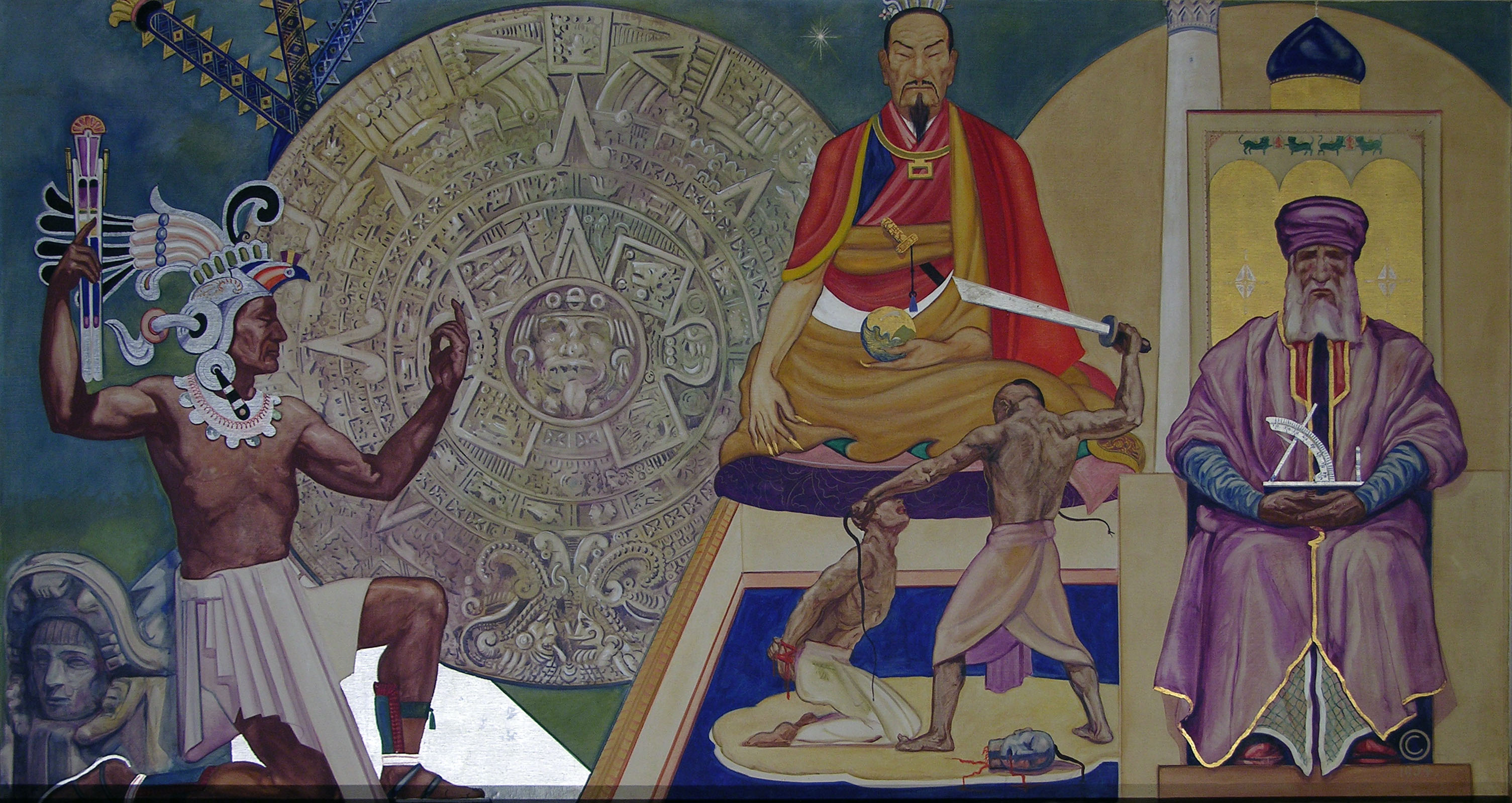Central Rotunda - Time Measurement

- John Mosley's Caption
- Monumental Men
- Source/Citations
From Mosley's pamphlet, "The Hugo Ballin Murals at the Griffith Observatory" (Los Angeles: Published by the Griffith Observatory, Department of Parks and Recreation, City of Los Angeles, 1998):
“At left, an Aztec points to the misnamed Aztec ‘Calendar’ stone from the fifteenth century. It is not a calendar but rather a symbolic emblem that involves astronomical cycles. The huge stone had little paint adhering to it when unearthed in 1790, but originally it was colorfully painted. (An interpretive model of the stone is exhibited in the East Hall.) The sun, Tonatiuh, is at its center. At lower left a head emerges from gaping mouth of the feathered serpent, a popular Mesoamerican deity.
At upper center is the Chinese Emperor Yao, who lived about 2300 B.C. and who is credited with early calendar reform. He holds a ball that symbolizes both the sun and the moon. The long sword is about to behead the second of two Chinese court astronomers, Hsi and Ho. According to tradition, they were punished because they were intoxicated and failed to perform the customary rites during an eclipse of the sun.
At right sits the Persian prince, Ulugh Begh, a grandson of the Mongol conqueror Tamerlane and the last great figure of the Islamic golden age of astronomy. In the 1420s he built an observatory at Samarkand, now in Uzbekistan, where he measure star positions with exceptional accuracy. Before telescopes, observatories generally contained giant sighting devices to measure star and planet positions. Ulugh Begh holds a model of one such measuring tool, a graduated meridian quadrant. He was murdered by his son in 1449 and only ruins of his observatory remain today."
This is the only panel that Ballin painted at the Griffith Observatory that does not include an Anglo European scientist in its portrayal of the "Advancement of Science." Instead Ballin featured scientific contributions from China, Mexico and the Middle East, celebrating the multicultural, interethnic influences on time telling and the diverse sources of our modern calendar. The emphasis on the Aztec figure and the large depiction of the Aztec calendar are particularly interesting given Ballin's exclusion of such indigenous Mexican culture from his other murals in the early 1930s and his open criticism of David Siquerios and the other Mexican muralists working in Los Angeles at the time. In a time when hundreds of Mexicans were being forcefully removed from the city, those other artists considered it their duty to draw attention to the plight of Mexican and Mexican Americans and celebrate Los Angeles' indigenous and Mexican cultural heritage.1 Ballin criticized the political character of their work and their more primitive and abstract painting styles, and instead offered more triumphant portrayals of Southern California's past in his other works. But in this panel and others at the observatory, the influence of those other muralists' work can be seen in Ballin's choice of subject matter. This panel educates the increasingly xenophobic public that "modern" science would not exist without the advancements made by scholars and scientists of other, non-western societies, and by extension, the positive contributions that non-white minorities could make to contemporary society. In this panel in particular, Ballin showed a desire to represent all of Los Angeles' multiethnic residents, suggesting the ideals about representation and public art held by Siquerios and Mexican artists in the 1930s influenced his work.
Caption excerpted from John Mosley's pamphlet, "The Hugo Ballin Murals at the Griffith Observatory" (Los Angeles: Published by the Griffith Observatory, Department of Parks and Recreation, City of Los Angeles, 1998).
1. From Schrank, Sarah, Art and the City: Civic Imagination and Cultural Authority in Los Angeles (Philadelphia: University of Pennsylvania Press, 2009), p. 490.
| Previous page on path | Griffith Observatory - Gallery, page 8 of 9 | Next page on path |

Discussion of "Central Rotunda - Time Measurement"
Add your voice to this discussion.
Checking your signed in status ...